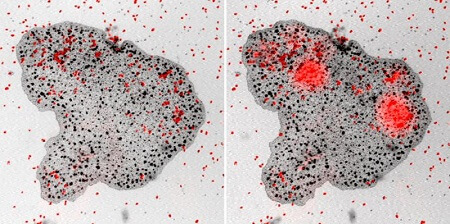 Trichoplax, a simple animal with no organs, feeds on microalgae (red specks) Trichoplax, a simple animal with no organs, feeds on microalgae (red specks) Psalm 136:25-26 Judging from the things many of us choose to eat, you'd be right in thinking that we sometimes don't use our brains when it comes to making healthy food choices. But a tiny multicellular animal, which scientists call "Trix" for short, doesn't use its brain at all at mealtime. In fact, it doesn't have a brain or a single nerve cell in its whole millimeter-sized body. So how is it that these tiny, brainless creatures are found worldwide, crawling across shallow seafloors on a belly covered in hairlike cilia in search of algae? Scientists have recently discovered that Trix have a whole bag of tricks that enable them to seek out algae with surprising sophistication. According to an article in LiveScience, when scientists used light and electron microscopy to look up close at Trix, they found two previously unknown cell types, giving Trix a total of six body cell types in all. By contrast, humans have hundreds of different cell types. Scientists think that one of these new cell types – which they call "crystal cells" – allows Trix to sense their environment, thus enabling it to find its lunch on the seafloor. Though scientists now know how Trix find food, they don't have a clue how they came to have these crystal cells to begin with. And they are utterly incapable of explaining how Trix survived before they supposedly "evolved" those cells. To creationists, however, it's crystal clear that God created this creature with all the cell types it needed to survive. Notes: N. Weiler, "No Organs, No Problem: Weird Animal Hunts Without Nerves or Muscles," LiveScience, 9/2/15. Photo: Credit: Carolyn Smith. Creation Moments, Inc., P.O. Box 839, Foley, MN 56329 www.creationmoments.com Comments are closed.
|
Archives
February 2020
|
Ads do not imply endorsement | Policy/Terms of Service | About Us | Contact Us | © Life Work Academy, Inc.
 RSS Feed
RSS Feed

